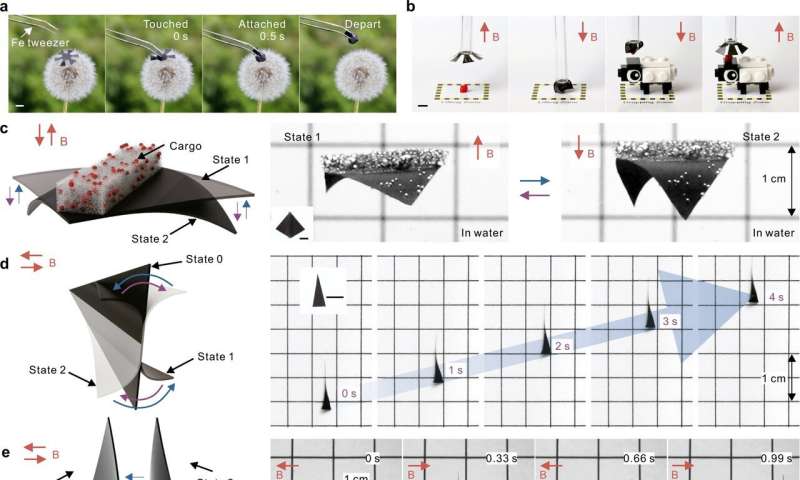a A six-arm robot on a dandelion can self-grip when approaching magnetic tweezers without harming the fragile structure of the flower. b The same robot can also grab, transport, and release nonmagnetic objects such as a polyurethane foam cube controlled by a permanent magnet. c Manta ray-shaped robot with a cargo swimming in water. d Triangle-shaped swimming robot twisting around its main axis and therefore moving forward in the water, both driven by a square wave magnetic field. e Triangle-shaped walking robot rolling itself in air at high speeds when subjected to an alternating magnetic field. Scale bars, 0.5 cm. Credit: Communications Materials (2020). DOI: 10.1038/s43246-020-00067-1
An international team of Johannes Kepler University researchers is developing robots made from soft materials. A new article in the journal Communications Materials demonstrates how these kinds of soft machines react using weak magnetic fields to move very quickly—even grabbing a quick-moving fly that has landed on it.
When we imagine a moving machine, such as a robot, we picture something largely made out of hard materials, says Martin Kaltenbrunner. He and his team of researchers at the JKU's Department of Soft Matter Physics and the LIT Soft Materials Lab have been working to build a soft materials-based system. When creating these kinds of systems, there is a basic underlying idea to create conducive conditions that support close robot-human interaction in the future—without the solid machine physically harming humans.
Stable, yet stretchable and flexible
In June, scientists presented a new approach for electromagnetic motors. Instead of copper wire and iron, elastic materials and liquid metal now form the basic ingredients for the so-called actuator. Scientists also recently introduced a new type of bio-gel in a journal article in Nature Materials which is elastic, flexible, and stable enough to be combined with electronic components in order to create a kind of "soft robot."
A team led by Kaltenbrunner and Denys Makarov (Helmholtz Center Dresden-Rossendorf) is now taking the development of these kinds of machines one step further. The two researchers noted that before, a drawback was that these wirelessly designed soft robots were only able to change shape very slowly. Their new idea is based on using the flexible plastic polydimethylsiloxane and mixing in magnetic microparticles such as an alloy of neodymium, iron and boron.
A flower-shaped robot momentarily closes around a fly before it registers the closing trap and releases it by opening its eight arms driven by an in-plane square wave magnetic field (3 mT, 50 Hz). The diameter of the robot is 25 mm with a thickness of 200 µm. Credit: Makarov, et al.; Communications Materials
A six-arm robot can grab, transport, and release non-magnetic objects such as a polyurethane foam cube controlled by a permanent magnet. The diameter of the robot is 20 mm with a thickness of 80 µm. Credit: Makarov, et al.; Communications Materials
A four-arm robot (weight of 23 mg) is located in a transparent glass tube and brought to levitation by a static out-of-plane magnetic field of 3.7 mT. The robot is actuated upon levitation. It deforms and configures itself spatially when exposed to an in-plane square wave magnetic field (1.5 mT, 50 Hz). The diameter of the robot is 15 mm with a thickness of 200 µm. Credit: Makarov, et al.; Communications Materials
The researchers gave their small, soft robots different shapes. Depending on the shape, where the microparticles were placed, and on the thickness of the materials used, the robots were able to move in different ways when exposed to a changing magnetic field in their environment. These actuators are just a few micrometers thin and a few micrograms in weight so they require little energy to move. In addition, the components can repeat the movements millions of times without any changes.
Hover, swim, catch flies
By influencing and changing the magnetic field, Kaltenbrunner and his colleagues have managed to build tiny robots that could hover, swim and—in the broadest sense—even walk. They also showed that in just a few milliseconds, their flower-shaped robots could catch a fly that had landed on it.
Designed by the simulations, a manta ray-shaped robot with a cargo can swim in water driven by an alternating in-plane square wave magnetic field (2 mT, 1 Hz). The lateral dimensions of the robot are 17 mm × 19 mm with a thickness of 80 µm. Credit: Makarov, et al.; Communications Materials
A triangle-shaped robot can roll itself in air at high speed and walk forward when exposed to an alternating in-plane square wave magnetic field (3.5 mT, 1.5 Hz). The diameter of the robot is 18 mm with a thickness of 80 µm. Credit: Makarov, et al.; Communications Materials
Scientists say this now paves the way to new opportunities to develop soft robots that also move very quickly. The long-term idea is to primarily produce more complex mini-machines that could, for example, help unblock blood vessels in the human body. In order to do this, the materials used would have to be biodegradable and easy to control.
More information: Xu Wang et al. Untethered and ultrafast soft-bodied robots, Communications Materials (2020). DOI: 10.1038/s43246-020-00067-1
Journal information: Nature Materials
Provided by Johannes Kepler University Linz
























